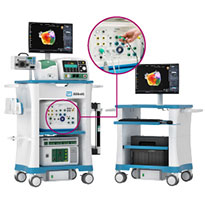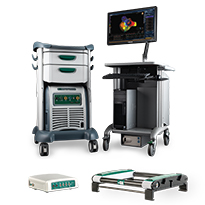Mapping Systems
Mapping systems use mapping catheters to measure the electrical activity of cardiac tissue and create comprehensive three-dimensional electroanatomic mapping of your patients’ hearts. Over the past 10 years, advances in cardiac mapping technology have provided improvements in stability, accuracy, speed and overall functionality.
EnSite™ X EP System with EnSite™ Omnipolar Technology
Revolutionize high-density cardiac mapping with EnSite™ X EP System and EnSite™ Omnipolar Technology (OT) — a next generation 3D mapping platform created to give you a powerful, reliable, and efficient user experience for every procedure.
EnSite Precision™ Cardiac Mapping System
The EnSite Precision™ Cardiac Mapping System offers advanced mapping that allows for a high level of automation, flexibility and precision to help you diagnose a wide range of arrhythmias.1,2
References
- Ptaszek LM, Moon B, Rozen G, Mahapatra S, Mansour M. (2018). Novel automated point collection software facilitates rapid, high-density electroanatomic mapping with multiple catheter types. J Cardiovasc Electrophysiol, 29(1), 186-195. https://doi.org/10.1111/jce.13368.
- Abbott. Data on file. Report 90237452.
Indications, Safety and Warnings
CAUTION: This product is intended for use by or under the direction of a physician. Prior to use, reference Instructions for Use, inside the product carton (when available) or at vascular.eifua.bbott or at manuals.sjm.com for more detailed information on Indications, Contraindications, Warnings, Precautions and Adverse Events.
Ensite Precision Cardiac Mapping System
Indications: The EnSite Precision™ Cardiac Mapping System is a suggested diagnostic tool in patients for whom electrophysiology studies have been indicated. The EnSite Precision™ System interfaces to either the MediGuide™ Technology System or the EnSite Precision™ Module to combine and display magnetic processed patient positioning and navigation mapping information. When used with the EnSite™ Array™ Catheter, the EnSite Precision™ Cardiac Mapping System is intended to be used in the right atrium of patients with complex arrhythmias that may be difficult to identify using conventional mapping systems alone. OR, when used with an EnSite Precision™ Surface Electrode Kit, the EnSite Precision™ Cardiac Mapping System is intended to display the position of conventional electrophysiology (EP) catheters in the heart.
Warnings: Refer to the ablation catheter labeling for a listing of adverse events related to the use of this device in conjunction with radio frequency ablation, as a part of the diagnosis and treatment of cardiac arrhythmias. For patient safety, any connections that directly connect the patient to the EnSite Precision Cardiac Mapping System must be routed through the appropriate module: EnSite Precision Link, Sensor Enabled™ NavLink, EnSite Precision Field Frame, ArrayLink, CathLink, SJM ECG Cable, RecordConnect, or GenConnect. When using the EnSite Precision Module full protection against the effects of cardiac defibrillator discharge and other leakage currents is dependent upon the use of appropriate cables. Refer to the ablation catheter labeling for a listing of adverse events related to the use of this device in conjunction with radio frequency ablation, as a part of the diagnosis and treatment of cardiac arrhythmias. For patient safety, any connections that directly connect the patient to the EnSite Precision Cardiac Mapping System must be routed through the appropriate module: EnSite Precision Link, Sensor Enabled™ NavLink, EnSite Precision Field Frame, ArrayLink, CathLink, SJM ECG Cable, RecordConnect, or GenConnect. When using the EnSite Precision Module full protection against the effects of cardiac defibrillator discharge and other leakage currents is dependent upon the use of appropriate cables.
Precautions: Do not operate the EnSite Precision Field Frame within 10 meters (m) of another operating Field Frame. Do not place the EnSite Precision Field Frame cable inside the measurement volume or wrap it around the Field Frame, as it may create a magnetic interference. Do not coil the EnSite Precision Field Frame cable. The cable carries enough electric current that a magnetic field will be created when the cable is placed in a circular formation. This magnetic field may disturb the Field Frame’s magnetic field. Do not place the EnSite Precision Link, Sensor Enabled™ within 1 m of the EnSite Precision Field Frame - Do not place tool cables within 30 millimeters (mm) of the EnSite Precision Field Frame cable. If placed this close—particularly if the cables are parallel to each other—the tool cable may become subject to electromagnetic interference. Metallic equipment used in close proximity to the magnetic field during the procedure, such as a sterile drape holder, may affect Sensor Enabled (SE) points and SE field scaling accuracy. Do not use the EnSite Precision Cardiac Mapping System in the presence of other magnetic fields. Do not drop the EnSite Precision Field Frame or subject it to impact. Physical damage to the Field Frame may alter the Field Frame’s factory calibration.
Ensite X EP System
Indications: The EnSite™ X EP System is a suggested diagnostic tool in patients for whom electrophysiology studies have been indicated. The EnSite™ X EP System provides information about the electrical activity of the heart and displays catheter location during conventional electrophysiological (EP) procedures.
Warnings: For patient safety, any connections that directly connect the patient to the EnSite™ X EP System must be routed through the appropriate modules: EnSite™ X EP System SurfaceLink Module, EnSite™ X EP System 20 pin Catheter Input Module, EnSite™ X EP System 80-pin Catheter Input Module and Direct Connect Ports on the EnSite™ X EP System Amplifier. When using the EnSite™ X EP System, full protection against the effects of cardiac defibrillator discharge and other leakage currents is dependent upon the use of appropriate cables. The use of this device in conjunction with radio frequency ablation, as a part of the diagnosis and treatment of cardiac arrhythmias, may pose an increased risk of adverse events such as cardiac perforation, myocardial infarction, air embolism, and hematoma requiring surgical repair and/or blood transfusion. Non-SE catheters cannot collect location data and should not be used for navigation in VoXel Mode because they do not have a magnetic sensor. However, they can be visualized and display intracardiac signals. Only connect items that have been specified as part of the EnSite X EP System or compatible with the EnSite X EP System to the multiple socket-outlets. The EnSite™ X EP System model display should be used in conjunction with conventional EP techniques to confirm catheter location. The AutoMark feature does not indicate lesion effectiveness. AutoMarks are placed based on user-defined parameters for catheter stability and RF metrics only. Sudden impedance changes of the body or catheter electrodes caused by the connection of other devices (e.g., stimulator, defibrillator, and other devices) may create a location shift.
Precautions: Ensure that surface electrodes, Patient Reference Sensors, and associated connectors do not contact one another, electrical ground, or metallic objects. Ensite™ X EP System components should be connected to power through an isolation transformer or the multiple socket outlet supplied with the system carts. Connecting equipment directly to a wall outlet may result in excessive leakage current. Do not operate the EnSite™ X EP System Field Frame within 10 m of another operating Field Frame. Do not place the EnSite™ X EP System Field Frame Cable inside the measurement volume or wrap it around the EnSite™ X EP System Field Frame, as it may create a magnetic interference. Metallic equipment used in close proximity to the magnetic field during the procedure, such as a sterile drape holder, may cause metal distortion. Do not place tool cables within 30 mm of the EnSite™ X EP System Field Frame Cable. If placed this close-particularly if the cables are parallel to each other the tool cable may become subject to electromagnetic interference. Do not use the EnSite™ X EP System in the presence of other magnetic fields. Do not drop the EnSite™ X EP System Field Frame or subject it to impact. Physical damage to the EnSite™ X EP System Field Frame may alter the EnSite™ X EP System Field Frame's factory calibration.
MAT-2008461 v2.0


